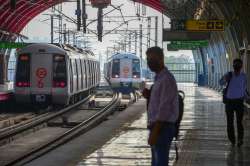Delhi Metro Phase IV's first tunnel boring machine being lowered
The lowering work of the first-ever Tunnel Boring Machine (TBM) of Delhi Metro's Phase IV has been started at Vikaspuri on the Janakpuri West-RK Ashram Marg corridor, a Metro official said.

The lowering work of the first-ever Tunnel Boring Machine (TBM) of Delhi Metro's Phase IV has been started at Vikaspuri on the Janakpuri West-RK Ashram Marg corridor, a Metro official said.
As part of this tunnelling drive, two tunnels, for up and down movement, of a length of 1.4 km will be bored between Vikaspuri and Krishna Park Extension.
"The tunnelling work with the TBM is expected to start next month, after the lowering and assembling of the giant 73-metre-long machine is completed. These tunnels will be located between the Janakpuri West and Krishna Park Extension stations of the corridor," said Anuj Dayal, Executive Director of DMRC's Corporate Communications.
"The tunnelling will start from Vikaspuri area in continuation of the Magenta line tunnel that has been already constructed for the presently operational Botanical Garden-Janakpuri West corridor."
The tunnel will be constructed approximately at a depth of 14 to 16 metres, and around 2,040 concrete rings will be installed in them. Each tunnel will have an inner diameter of 5.8 metres.
The entire tunnelling work on this stretch is expected to be completed in about 15 months' time. The alignment of the tunnel will be along the Outer Ring Road.
As part of the Phase-IV work approved so far, about 27 km of underground lines will be constructed. The Janakpuri West-RK Ashram Marg corridor will have underground sections of 7.74 km in total.
A TBM is a machine used to excavate tunnels with a circular cross-section through a variety of soil and rock strata. They can be designed to bore through anything from hard rock to sand. TBMs have revolutionised the way tunnelling work is done all over the world as now tunnels can be bored without disturbing the buildings and other structures on the surface.
TBMs are especially useful for underground tunnelling work in congested urban areas, and the DMRC has been using TBMs for its tunnelling work since Phase I. In Phase III, when about 50 km of underground sections were built, about 30 TBMs were pressed into service in the national capital.